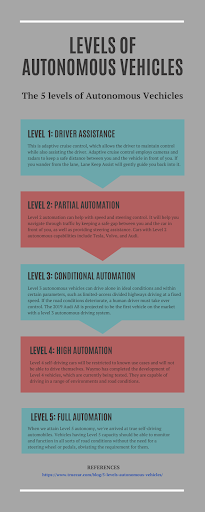 The cars we know today have come a long way in the last century, with improved space for passengers, more technology, like Bluetooth, hard drives, advanced safety systems, GPS, and WiFi. The way advancements in technology are heading, by 2030 the conventional automobile will have progressed from just supporting the driver to taking complete control of all elements of driving. Tesla might be one of the names that we may see in the automotive industry in the near future, as it is leading the charge for the automobile future. Tesla, Elon Musk's electric car firm, was launched on the premise that it would be the future of driving.
The cars we know today have come a long way in the last century, with improved space for passengers, more technology, like Bluetooth, hard drives, advanced safety systems, GPS, and WiFi. The way advancements in technology are heading, by 2030 the conventional automobile will have progressed from just supporting the driver to taking complete control of all elements of driving. Tesla might be one of the names that we may see in the automotive industry in the near future, as it is leading the charge for the automobile future. Tesla, Elon Musk's electric car firm, was launched on the premise that it would be the future of driving.
5 Levels of Autonomous Cars
When you think of an autonomous car, you probably think of a car that can drive you to work and to the store. But the truth is that automation is much more than self driving cars, there are 5 stages which autonomous cars can come in, from cars that assist you, to cars that will drive for you.
Level 0 is No automation, your typical automobile. Simple cruise control to aid long-distance driving and reduce the possibility of receiving a speeding ticket.
Level 1 is Driver Assistance, this is your adaptive cruise control, where the driver is still going to be in control, but it assists the driver. Adaptive cruise control uses cameras and radars to maintain a safe distance between you and the car ahead of you, automatically applying brakes when traffic slows and resuming speed when traffic clears. If you stray from the lane, Lane Keep Assist will gently guide you back into it.
Level 2 is Partial Automation, level 2 automation can help with speed and steering control. It will aid you in traffic by maintaining a safe distance between you and the vehicle in front of you, as well as steering assistance by keeping the car centered inside the lane. Cars such as Tesla, Volvo, and Audi are some cars of Level 2 autonomous capabilities.
Level 3 is Conditional Automation, Level 3 autonomous cars can drive themselves, but only under perfect conditions and with specific limits, such as limited-access divided roads traveling at a set speed. In the event that road conditions deteriorate, a human driver must take control. The 2019 Audi A8 is projected to be the first vehicle on the market with a level 3 autonomous driving system.
Level 4 is High Automation, Level 4 autonomous cars will be limited to recognized use cases and will not be able to drive themselves. Waymo has built and is testing Level 4 vehicles that can drive autonomously in a wide range of situations and road conditions.
Level 5 is Full Automation, we arrive at real autonomous cars when we reach Level 5 autonomy. Vehicles with Level 5 capability should be able to monitor and operate through all types of road conditions with no human interaction, nullifying the need for a steering wheel and pedals.
Companies in the Industry
Three of the major companies racing towards fully autonomous cars may not be who you think. AImotive, Waymo, and Zoox are companies that are all promising level 5 autonomous technology.
AImotive was founded in 2014 by Laszlo Kishonti. It is located in Budapest, Hungary, and has raised 67 million dollars in funding. AImotive wants to deliver self-driving vehicles to the streets quicker and for less money than its competitors. Instead of pricey lidar laser technology, the firm uses cameras and redundant sensors. Instead of developing a self-driving vehicle in-house, AImotive wants to create a technology that can be readily transferable to other automakers.
Waymo was founded in 2009 by Alphabet Inc; it is located in Mountain View, California, and has raised over 2.5 Billion dollars in funding. Waymo's self-driving technology is now available, and fully autonomous cars are being tested on public roads in 25 cities throughout the United States. In October 2015, Waymo became the first company to take a completely autonomous ride on public roads in a car without a steering wheel or pedals. Waymo and Jaguar Land Rover recently announced a partnership to equip up to 20,000 Jaguar I-PACE vehicles with Waymo's self-driving technology. With its new battery-electric platform, this in-house built luxury automobile will be able to go 240 miles on a single charge.
Zoox was founded in 2014 by Jesse Levinson and Tim Kentley-Klay, it is located in Menlo Park, California, and has raised 1 Billion dollars in funding. Zoox aspires to create a Level 5 completely autonomous vehicle with no steering wheel and seating organized similarly to that of a mass transit vehicle. The 1 billion in investment will be used not just to develop self-driving technology, but also to construct a new sort of automobile that is self-driving from the start. Zoox is keeping its goals under wraps for the time being.
Dangers of Autonomous Cars
These changes come with dangers though. According to The New York Times, in 2019, Kevin George Aziz Riad was driving home in his Tesla Model S on Autopilot when he reached down to pick up his telephone. A 22-year-old college student was killed after the automobile sped through a stop sign and a flashing red light and collided with another vehicle.
According to the New York Post, prosecutors in Los Angeles filed a criminal case against Kevin George Aziz Riad in October of 2021. Riad, 27, was engaged in an accident with Gilberto Alcazar Lopez and Maria Guadalupe Nieves-López, both of whom were killed, according to the lawsuit. Riad is facing two charges of vehicular manslaughter, one of which is a felony. This is the first ever felony charge against a driver using autopilot. This shows that as impressive as the technology seems right now, we still have a long way to go until we can fully rely on technology to drive our cars for us.
The conclusion is that while autonomous vehicles may be the future of our cars, as amazing the technology seems right now, we still have a lot more ground to cover until we can have safe and accessible fully autonomous vehicles.



